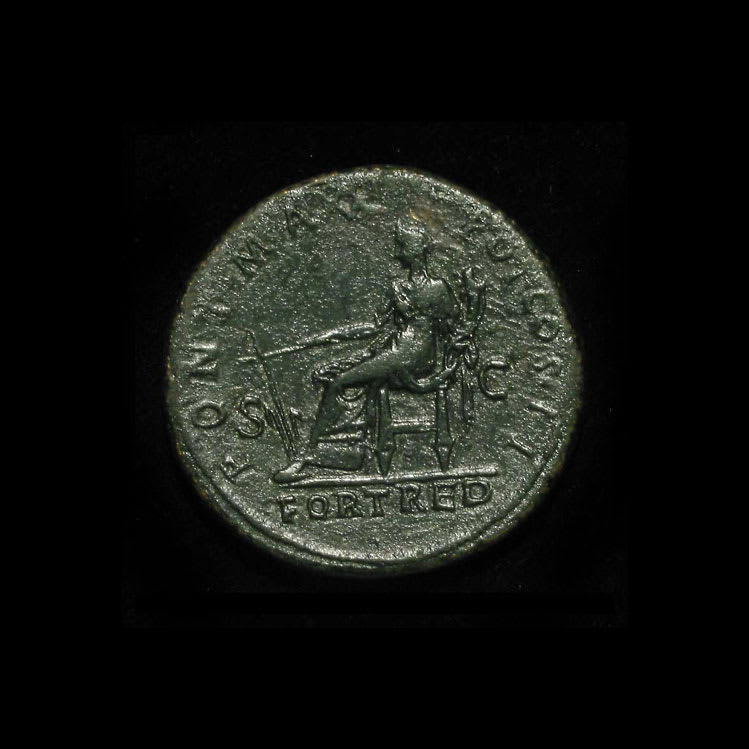Bronze Sestertius of Emperor Hadrian, 118 CE
Bronze
C.4056
A well-struck and impressive coin from the reign of Hadrian. Obverse: IMP CAESAR TRAIAN HADRIANVS AVG; Laureate Bust of the Emperor Facing Right Reverse: PONT MAX TR POT COS II...
A well-struck and impressive coin from the reign of Hadrian.
Obverse: IMP CAESAR TRAIAN HADRIANVS AVG; Laureate Bust of the Emperor Facing Right
Reverse: PONT MAX TR POT COS II / FORT RED / S C; Fortuna Enthroned to the Left, Holding Cornucopiae and Rudder
Fortuna is the Roman Goddess of fortune, and is the Roman equivalent of the Greek goddess Tyche. The cornucopia she is holding is also known as a horn of plenty, perhaps a reference to the prosperity Rome had gained under Hadrian’s rule. The rudder may reflect the fact that the emperor spent much of his time travelling about the Roman world, checking on the stability of the empire’s fringes.
Coinage operates as a propagandist device in all cultures, and particularly during the Roman Empire when the borders were uncertain and internal strife threatened to destabilise the economy. Hadrian, like all other emperors, sought to associate himself with positive iconography and heroic imagery. As it happened, he deserved them more than subsequent, decadent emperors, who squandered the stability his conservative and comparatively peaceful rule had engendered.
Publius Aelius Hadrianus, better known as Hadrian, was born in Spain in 76 AD and died in 138 AD. He ruled the Roman Empire from 117 to 138, during which time the Empire reached its apotheosis. Being the third of the so called Five Good Emperors, his rule was characterised by comparatively humanitarianism and conservatism. Following a political career of some distinction - he served as prefect, legate, consul, tribune and senator - it was his expedition to Parthia with Trajan led to his greatest success; Trajan became seriously ill and died on the way back to Rome, naming Hadrian as successor. Hadrian purged the senate of opposition upon his return to Rome, and set about a somewhat conservative reign that involved strengthening the empire's boundaries and the surrender of indefensible areas (i.e. Mesopotamia). He was known more for rule by threat and strength than active military conquest.
Personally, he was well educated and fond of the great Greek writers and philosophers, and was even appointed Archon in Athens. He was a great patron of the arts, including landscaping and architecture: under his reign the Pantheon was rebuilt, as well as many libraries, aqueducts, libraries and theatres. He was also a keen poet, an Epicurean philosopher and a huntsman, commissioning various reliefs showing him killing bears, lions etc. He is also notable for introducing the socially-acceptable beard - all other emperors before him had been clean shaven. The great love of his life was a boy named Antinous, which may explain the lack of natural heirs to Hadrian's lineage. Antinous drowned in the Nile aged about 19; the mourning Hadrian had him deified.
This is a striking and attractive ancient coin.
Obverse: IMP CAESAR TRAIAN HADRIANVS AVG; Laureate Bust of the Emperor Facing Right
Reverse: PONT MAX TR POT COS II / FORT RED / S C; Fortuna Enthroned to the Left, Holding Cornucopiae and Rudder
Fortuna is the Roman Goddess of fortune, and is the Roman equivalent of the Greek goddess Tyche. The cornucopia she is holding is also known as a horn of plenty, perhaps a reference to the prosperity Rome had gained under Hadrian’s rule. The rudder may reflect the fact that the emperor spent much of his time travelling about the Roman world, checking on the stability of the empire’s fringes.
Coinage operates as a propagandist device in all cultures, and particularly during the Roman Empire when the borders were uncertain and internal strife threatened to destabilise the economy. Hadrian, like all other emperors, sought to associate himself with positive iconography and heroic imagery. As it happened, he deserved them more than subsequent, decadent emperors, who squandered the stability his conservative and comparatively peaceful rule had engendered.
Publius Aelius Hadrianus, better known as Hadrian, was born in Spain in 76 AD and died in 138 AD. He ruled the Roman Empire from 117 to 138, during which time the Empire reached its apotheosis. Being the third of the so called Five Good Emperors, his rule was characterised by comparatively humanitarianism and conservatism. Following a political career of some distinction - he served as prefect, legate, consul, tribune and senator - it was his expedition to Parthia with Trajan led to his greatest success; Trajan became seriously ill and died on the way back to Rome, naming Hadrian as successor. Hadrian purged the senate of opposition upon his return to Rome, and set about a somewhat conservative reign that involved strengthening the empire's boundaries and the surrender of indefensible areas (i.e. Mesopotamia). He was known more for rule by threat and strength than active military conquest.
Personally, he was well educated and fond of the great Greek writers and philosophers, and was even appointed Archon in Athens. He was a great patron of the arts, including landscaping and architecture: under his reign the Pantheon was rebuilt, as well as many libraries, aqueducts, libraries and theatres. He was also a keen poet, an Epicurean philosopher and a huntsman, commissioning various reliefs showing him killing bears, lions etc. He is also notable for introducing the socially-acceptable beard - all other emperors before him had been clean shaven. The great love of his life was a boy named Antinous, which may explain the lack of natural heirs to Hadrian's lineage. Antinous drowned in the Nile aged about 19; the mourning Hadrian had him deified.
This is a striking and attractive ancient coin.



